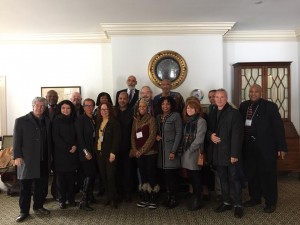
Scholars from four continents gathered in the World Heritage listed Rotunda at the University of Virginia in Charlottesville for a two-day conference on “Interpreting and Representing Slavery and its Legacies in Museums and Sites: International Perspectives” (March 19-20 2018). The conference explored the variety of ways universities, historic sites and museums from around the Atlantic World tell the story of slavery and its far reaching legacy. The project was sponsored by The conference is sponsored by Thomas Jefferson’s Monticello, the University of Virginia (UVA), and the United States Committee of the International Council on Monuments and Sites (US/ICOMOS) in collaboration with the United National Educational, Scientific, and Cultural Organization (UNESCO) Slave Route Project: Resistance, Liberty, and Heritage.
Launched in 1994 the Slave Route Project explores the common links between Africa and the Americas. As described by Professor Paul Lovejoy in his article The African Diaspora: Revisionist Interpretations of Ethnicity, Culture and Religion under Slavery it was the aim of the UNESCO project to “trace the slave trade from the original points of enslavement in the African interior, through the coastal (and Saharan) entrepots by which slaves were exported from the region, to the societies in the Americas and the Islamic world into which they were imported.”

In this the project has been very successful. The research that underlies the Slave Route Project includes extensive work on the history from the Africa perspective a topic that from the American side has been neglected or is just not well known. This is critical for understanding how enslaved Africans perceived this new world and modified traditional institutions and cultural practices to adapt to new conditions. The some of the publications from the project are featured on this web site.
The overall goal is to develop through a range of cultural and educational programs to enhance enhances awareness of this slavery and its consequences. The recent conference at UVA featured museum and historic site practitioners, as well as scholars and public thought leaders who engaged in a knowledge exchange to:
- Consider the global impact of the slave trade and the legacies of slavery
- Discuss experiences and best practices on representing and interpreting slavery from different regions of the world
- Examine the roles of the arts, humanities, and multimedia technology for interpreting and representing the memory and history of slavery
- Contribute to the elaboration of a handbook on new approaches in interpreting and representing slavery in museums and sites
- Explore opportunities and possibilities for partnerships among participants and with the UNESCO Slave Route Project.
Below are just a few observations from what was an extraordinarily rich conference. Fortunately, for those who were not able to attend the conference in person, the conference panels are already available to view on line.
Use of big data
The Slave Routes project has generated a vast amount of data on the 12.5 million enslaved people brought to the new world. The availability of this information is one of the ways to break the chain of silence. And this information is about to become even more accessible. The Mellon Foundation has awarded a grant of $1.47 million to eight universities to link their individual data bases. When finished, the project, “Enslaved: The People of the Historic Slave Trade,” will enable scholars and the public to search millions of pieces of slave data to identify enslaved individuals and their descendants. Users also will be able to run analyses of enslaved populations and create maps, charts, and graphics. (Hear Dr. Paul Lovejoy speak on this initiative at the First Session at the conference)
Making the connection to individuals

While the scale of the slave trade is important to understand, the conference speakers emphasized the need to recognize the individuality and humanity of each enslaved person. Both the Provost Dr. Louis Nelson and the President Dr. Teresa Sullivan in their introductory remarks used the names of the enslaved laborers who constructed the Rotunda where we were meeting. Other projects are underway to build a data base of enslaved individuals to break the silence by putting a name to each enslaved person. (Listen to Session One – Welcome to the conference)
The psychological impacts of slavery
One of the most powerful presentations at the conference was by Dr. Benjamin Bowser who addressed the long term consequences of the slave trade on mental health. These impacts have long gone unrecognized yet still influence behavior today. (Listen to Dr. Bowser speak at the Second Session)
Role of museums and universities
The overall goal of the conference was to examine the variety of approaches used at museums and sites around the Atlantic to represent the history and legacies of the slave trade, slavery, as well as emancipation with experts from the U.S. South Africa, the Netherlands, France and more. While this topic infused all the sessions at the conference, the panel on ‘Universities Confronting Slavery’ raised many challenging questions. Such as many universities are historical actors with connections to slavery, what steps have these universities taken towards repairing historic injustices? (Listen to session 5 for more information)
Importance of the arts and humanities

Also permeating the conference and rare at a history conference were the role of arts and humanities as an essential part of the story. Many speakers looked at how the arts can play a role in expressing and transmitting memory. (Listen to Mr. Ed Dwight speak on creating memorials to slavery on Session Six panel)
Again don’t just stop with my brief summaries of a few of the conference highlights. Go to the conference web site and listen in!


